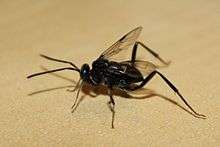Evania appendigaster
| Evania appendigaster | |
|---|---|
 | |
| Scientific classification | |
| Kingdom: | Animalia |
| Phylum: | Arthropoda |
| Class: | Insecta |
| Order: | Hymenoptera |
| Superfamily: | Evanioidea |
| Family: | Evaniidae |
| Genus: | Evania |
| Species: | E. appendigaster |
| Binomial name | |
| Evania appendigaster Linnaeus, 1758 | |
| Synonyms | |
|
Evania affinis | |
Evania appendigaster is a species of wasp in the family Evaniidae, the ensign wasps. Its native range is not known, but it likely originated in Asia. Today it occurs throughout the tropics and subtropics and in many temperate regions. It is a parasitoid wasp known for specializing on cockroaches.[1]
Description

This is one of the larger ensign wasps, with forewings up to about 7 millimeters long. It is distinguished from other species by the wide separation of the first and second sections of the coxa, the segment of the leg that attaches to the body. It is black in color. The abdominal petiole, the constricted stalk that holds the posterior section of the abdomen, or gaster, is attached high on the body. The gaster is laterally compressed and oval to nearly triangular in shape, held in a flaglike fashion and resembling an ensign, a characteristic of the family that inspired the common name ensign wasp.[1]
Biology
This wasp reproduces by laying eggs in the egg cases, or oothecae, of cockroaches. The wasp larvae use the cockroach eggs as a food source. Host cockroaches include the American cockroach (Periplaneta americana), Australian cockroach (P. australasiae), brown cockroach (P. brunnea), Oriental cockroach (Blatta orientalis), whitemargined cockroach (Melanozosteria soror), and harlequin cockroach (Neostylopyga rhombifolia).[2]
Detailed descriptions of the oviposition process in this species have been published. As one 1920 account describes it, "the Evaniid left the inside wall of the confining tumbler, ran over the Blattid ootheca, crawled over the surface momentarily as she actively vibrated her antenna and finally settled upon it with the long axis of her body parallel with the long axis of the egg mass as it lay upon its right side. Having satisfactorily settled herself, lying upon her right side she extended her ovipositor and crawling slightly forward she punctured the ootheca in the fifth egg cell of the left side, remaining in position for about fifteen minutes. She then left the egg mass and resting upon the inside wall of the tumbler actively cleaned the ovipositor, wings and antennae."[3]
As a 1957 account describes the "peculiar" egg-laying behavior, "the female lies on her side and, with legs braced against the oötheca, penetrates the tough integument of the egg-capsule after about half-an-hour's hard labour."[4] The process apparently requires "a good deal of hard work and much wriggling of the abdomen."[1]
Other authors describe it as a seven-step process. The wasp lands on the ootheca and drums on it with her antennae. During step two, she extends her ovipositor and taps on the ootheca in several places for up to ten minutes, apparently searching for an appropriate site. After a rest period she begins "drilling", repeatedly inserting her ovipositor. Step five is the actual oviposition stage, in which wasps "just sit on ootheca and lay eggs".[2] Steps six and seven are the withdrawal of the ovipositor and departure, respectively.[2]
One egg is deposited in each cockroach egg capsule, and the wasp larva consumes all the eggs within it.[4] The larva proceeds through five instars during development, stages which are distinguished by the changes in the unique mandibles. The first instar has mandibles with small, sharp teeth which it must use to open the tough cockroach eggs.[1][4] During the next two instars, the larva has longer mandibles which are "shaped like a gauntlet glove"[4] with three teeth. The final two instars have thicker mandibles with a long, blunt upper tooth and a narrow, curving lower tooth.[1]
When the larva reaches about 8 millimeters in length it pupates. Upon maturity it cuts a hole in the egg capsule and exits. The adult wasp lives for two or three weeks. It may spend some time on plants such as parsley and fennel.[1]
Competitors include Aprostocetus hagenowii, another parasitoid wasp that attacks cockroach oothecae.[1]
Research
The complete mitochondrial genome of this species has been sequenced.[5]
The wasp may be a candidate for use as an agent of biological pest control of cockroaches.[4][6] Control might be even better if the wasp were released along with A. hagenowii, which tends to have a higher rate of parasitism.[1]
References
| Wikimedia Commons has media related to Evania appendigaster. |
- 1 2 3 4 5 6 7 8 Strange, L. A. A Cockroach Egg Parasitoid, Evania appendigaster (Linnaeus) (Hymenoptera: Evaniidae). EENY-162 (IN319). Entomology and Nematology. Florida Cooperative Extension Service. University of Florida IFAS. 2000.
- 1 2 3 Yeh, C. C., et al. (2000). Prior experience affects the oviposition behavior in Evania appendigaster (L.) (Hymenoptera: Evaniidae). Chin. J. Entomol 20, 13-21.
- ↑ Haber, V. R. (1920). Oviposition by an evaniid, Evania appendigaster Linn. The Canadian Entomologist 52, 248.
- 1 2 3 4 5 Cameron, E. (1957). On the parasites and predators of the cockroach. II. – Evania appendigaster (L.). Bulletin of Entomological Research 48, 199-209.
- ↑ Wei, S. J., et al. (2010). The complete mitochondrial genome of Evania appendigaster (Hymenoptera: Evaniidae) has low A+ T content and a long intergenic spacer between atp8 and atp6. Molecular Biology Reports 37(4), 1931-42.
- ↑ Hwang, S. Y. and L. M. Chen. (2004). Effects of four physical treatments of oothecae of Periplaneta americana on parasitism and development of parasitic wasp Evania appendigaster. Environmental Entomology 33(5), 1321-26.